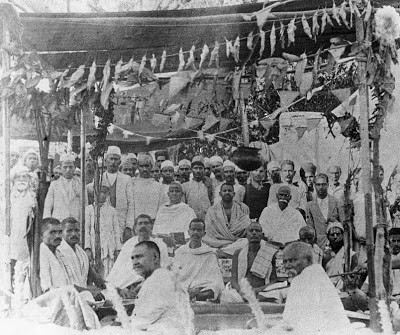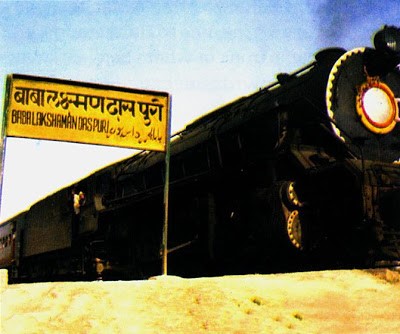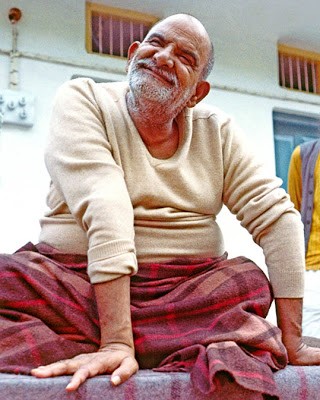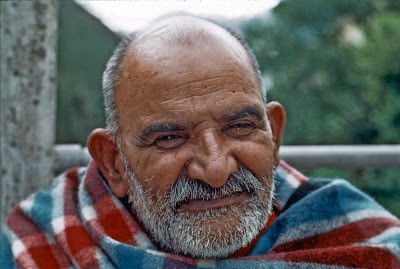About Maharaj Ji
Baba Neeb Karori Maharaj was born in the village “Akbarpur” (Now in Firozabad district earlier in Agra district) of Uttar Pradesh (India) in a wealthy jamindar (landlord) family. He was born on Shuklpaksh Ashtmi in the month of Margsheersh. His father’s name was Shri Durga Prasad Sharma and mothers name was Smt. Kausalya Devi. At the time of his birth scholars announced that he will never shortfall of money in his life.
His mother died in his early age. He was 8-9 year old at that time. He was married to ShubhshriRam Beti of village Badam Baas at the age of eleven years. Maharaj ji left his home at the age of twelve and return after the gap of 10 to 12 years. Nothing can be said precisely about the activities of Maharaj ji during these years but considering the facts we get the following information about those years.
First he went to Rajasthan from there he went to Rajkot, Gujarat. Head of the temple was very much pleased with him by his service and devotion. He declared him as his successor. With this decision of head, some of his colleagues were not happy. To avoid any controversy he left the place. After that he reached to Bavania village of Morbi district(Gujarat). There he continued his sadhana in a water pond near Ramabai Ashram. He meditated for hours in pond. There he was known as Talaiyaa Baba. After some time he left Bavania and reached to Neeb Karori village in Farrukhabad district of Uttar Pradesh.


From Babania, Maharaj ji set off on a journey around the country. While traveling, he arrived at the village “Neeb Karori”, in the district of Farrukhabad, and there he stopped to take some rest. Maharaj ji's speech was divine, and although he had little contact with the villagers, whatever he told them came true. They became attached to him and beseeched him to stay. They built an underground cave for him in which he immersed himself in spiritual practice all day. No one saw him coming out even to attend the call of nature. He came out only in the darkness of night. Later a new cave (which still exists) was dug out about two hundred meters from the old one, on a neglected piece of land owned by a Brahmin named Goverdhan. Maharaj ji had a Hanuman temple built on the roof of this cave, and on the day of consecration he shaved his long, matted hair and started wearing a long, cotton dhoti (length of cotton fabric) instead of the loincloth.
After moving into the new cave, Maharaj ji started interacting more with the villagers. He developed a friendly association with the younger people of his age group and often participated in their sports. He mingled with them so freely that it was not possible for them to be over-awed by the peculiarities of his astonishing deeds. While playing hide-and-seek, he was able to locate any one of them instantly, wherever they might be hidden in the forest, but when his turn came, he became invisible and was not to be found anywhere. While climbing trees in the forest, his pursuers would follow him up one tree only to reach the top and see him sitting on another. No one saw him leaping from tree to tree. While swimming in the village pond, Baba would disappear under the water and come out after a long time. It was all a matter of amazement and fun for them. During this period a poor bird catcher named Gopal became Maharaj ji’s ardent devotee and came to attend to him every day. One day, forgetting Maharaj Ji’s instructions not to enter his cave, Gopal made the mistake of going in with a pot of milk that he had brought for him. He found Maharaj Ji in deep meditation with serpents wrapped around his body. He was so horrified to see Maharaj Ji in his Shiva-like form that his legs gave way and the pot of milk slipped from his hands. He ran outside and fainted. Maharaj ji came out and lifted him up saying, “You should not have entered the cave without permission.” It was by Maharaj Ji’s touch alone that Gopal regained consciousness. One time Maharaj ji did not get food for several days. This was more of his Lila. The villagers said that he appeared agitated. He shouted at the holy image of Hanuman (an incarnation of Shiva and beloved devotee of Lord Ram, he is the reliever of suffering, the embodiment of blessings, and a bridge between people and God), “Will you starve me to death?” No sooner did he say these words than several people came to the temple with plates full of fruits and sweets. Showing disrespect to the deity was an incomprehensible act, but the villagers believed that Maharaj ji could do such a thing because he was not a devotee of Hanuman but Hanuman himself. One day Maharaj ji was on his way to the Ganges, where he used to bathe on the auspicious days of Ekadashi and Purnima. He was walking with his devotee Gopal and a Muslim companion when he saw a train traveling towards Farrukhabad on which he wished to travel. The moving train, which was about two hundred meters away, suddenly stopped and did not move further until Maharaj ji and his attendants boarded. As soon as Maharaj ji sat down, the train continued its journey. Later on, at the request of villagers who wished to keep the memory of the event alive, the government of India set up a railway station at the place where Baba boarded and named it Baba Lakshman Das Puri station after Maharaj ji. (Maharaj ji was called Baba Lakshman Das by the villagers of Neeb Karori.)


On another occasion Maharaj ji went to Farrukhabad from Neeb Karori in the first-class compartment of a train. Seeing his sadhu-like appearance, an Anglo-Indian conductor told him to get off the train at the next station. Maharaj Ji got down and took a seat on the platform. Despite all efforts of the station staff, the train did not move; its departure was delayed for two hours. The conductor could not explain the problem since no mechanical defect was found. In fact, the engine was running, but the wheels would not turn. All the compartments of the train were checked thoroughly and no fault was found anywhere. While the authorities were deliberating over the problem, some railway employees asked Maharaj ji in jest to make the train move. Maharaj ji said, “I am turned out of the train and you are asking me to let it go!” An employee replied, “Perhaps you had no ticket.” At this, Maharaj ji showed them several genuine first-class tickets. Amazed, they begged him to re-board the train and let it move. Maharaj ji willed it to be so, and the train moved instantly. From then on Baba Lakshman Das became famous as Baba Neeb Karori, the baba from Neeb Karori village. In 1935 a rich man came to Neeb Karori and offered Maharaj ji a silver plate full of gold coins in the presence of Goverdhan and some other Brahmins. Maharaj Ji did not accept the offering. His rejection of it antagonized the Brahmins, for they had wanted Maharaj Ji to give them the money. Later another rich man came to Neeb Karori bringing thirty cans of ghee (clarified butter) for the forthcoming yagna (fire ceremony) on the full-moon day. Maharaj Ji was in Farrukhabad at the time, taking a bath in the Ganges. In his absence the Brahmins spoke to the rich man in a derogatory way about Maharaj ji and persuaded him to go away with his cans of ghee. Maharaj ji could see all that was happening at Neeb Karori from Farrukhabad, and on his return he reprimanded the Brahmins and gave up the idea of performing the annual yagna. One day shortly thereafter, he left the village. He had lived there for eighteen years. After leaving Neeb Karori, Maharaj ji lived for some time on the bank of the Ganges at Kilaghat in Fatehgarh. There he associated with the local people and even reared some cows. To the amusement of his devotees, the cows obeyed Maharaj Ji’s commands. During his stay he gave his blessings and darshan to many soldiers. He also changed the heart of Colonel J.C. McKenna, his first western devotee, who had been averse to Indian saints and monks. After leaving Kilaghat, Maharaj ji wandered from place to place. Nothing can be said for certain about where he went and what he did during this time. There was, however, a steady growth of reverence for him among people in the towns of Bareilly, Haldwani, Almora, Nainital, Kanpur, Lucknow, Vrindavan, and Allahabad, and also in Delhi, Shimla, and even Madras (Chennai), a far-off city in the South. Without any publicity, urban and rural Indians of all ages, castes, and classes, as well as people from the West became Baba’s devotees. Hindus, Muslims, Sikhs, Christians, and even atheists were drawn to him. V.V. Giri, (Former President of India), Gopal Swarup Pathak (Former Vice President of India) Justice Vasudev Mukherjee, Jugal Kishore Birla( (Famous Industrialist) Sumitra Nandan Pant(The Poet), Dada Sudhir Mukherji (Professor Allahabad University), Ram Dass ( Harvard Professor), Krishna Dass (Grammy award nominee) Jai Uttal ( Famous Musician) and Dr. Larry Brilliant (U.N.O. Small Pox eradication program) and many other noted personalities were great devotees of Maharaj ji.
Steve Jobs (Apple Computers), Mark Juckerberg (Facebook), Julia Robert (Hollywood Actress),and many other well-known and distinguished persons were not lucky enough to have darshan of Maharaj ji in person but have great respect for him. During the 1940s Maharaj ji began spending more time in Nainital. Many of the town’s inhabitants became devoted to him. If they saw Baba going anywhere, they would leave their business or chores and like carefree beings, follow him wherever he went. There was an inexplicable bliss in the households that Maharaj ji visited. No effort was needed to find out where he was in the town at any particular moment because his presence could be felt by the spirit of joy and festivity pervading that place. He would occasionally stay in the houses of his devotees, but he spent much of his time on the secluded Manora hillside, about two kilometers outside of the town. Sometimes he would pass the nights on the roadside parapets, and householder devotees accustomed to domestic comforts would remain awake with him all night, night after night, and still attend to their usual routine during the day. Instead of feeling fatigued, they felt a new spirit of energy.
In the early 1950’s Maharaj ji started to build first temple, which he named Hanumangarh, constructed on the Manora hillside. Over the next two decades he also had temples, and in some places ashrams, constructed in Bhumiadhar, Kainchi, Kakrighat, Vrindavan, Kanpur, Lucknow, Shimla, Delhi, and other places. Maharaj ji valued the temples and ashrams, but he had no desire or attachment for them. As soon as each temple was completed, he would turn its management over to a local trust.
Because of the social limitations faced by women in India, Maharaj ji made special facilities available to them in the ashrams. Consequently the women devotees adored Maharaj ji as their guru, father, brother, or son, according to their feelings. They participated in all the activities of the ashrams and contributed greatly to the spirit of service that Maharaj ji encouraged.
Many visitors were fed every day in Maharaj ji's ashrams and given packets of Prasad (blessed food) to carry home for their families. The visiting ascetics were offered money and blankets as well as food. Maharaj ji would say, "If you do not empty the stock, how can it be replenished?" Just as the sun never sees darkness, Maharaj ji never faced a shortage of anything.
He devoted time towards his responsibility of a householder and at the same time he continued to look after his bigger family i.e.; the world at large. However, there was no difference in his life and style of living when discharging his duties of a householder or that of a saint. In his family as a householder he has two sons and a daughter.
From the 1950’s until his Mahasamadhi, Maharaj ji visited the temples and ashrams but never stayed in one place for long. Wherever he stayed, he lived simply and was always concerned with the welfare of others. Like a benevolent father, he shed his grace on all.
Maharaj ji's devotees came from all walks of life, and although some of them led lives of dissipation, he did not always insist on making them give up their bad habits. On the contrary, he gave them opportunities to carry on and spent time in their company. In due course they gave up their bad habits on their own. He often told people, "All are born into this world with natural wisdom and God is the great giver of this wisdom." Whenever Maharaj ji addressed an atheist or a wicked person as a devotee or saint, he showed a seed of goodness that often brought about a change. With the passage of time, the seed would sprout, grow, bloom, and finally bear fruit. It was common for such people to pass through a transformation.
Maharaj ji treated everyone equally. Although saints generally maintain distance from women, Maharaj ji mingled with them freely. He could playfully hold the hand of any woman and without any hesitation, catch hold of her nose and tweak it for fun. Nothing was seen as inappropriate in his behavior. Both male and female devotees pressed and massaged his feet. His presence and touch communicated such good thoughts and feelings that everyone felt uplifted. Maharaj ji regarded all human beings as his own children and treated them accordingly. He often said, "You feel pestered with a few children, but I have so many."
Like parents with children, Maharaj ji was familiar with everyone. He addressed even eminent persons using the words "tu" and "tum" [In the Hindi language, both "tu" and "tum" mean "you," but they are used to address people of inferior status or as a term of endearment] and he used "hum" (we) to refer to himself. His use of informal language was soaked with love and affection. His utterances, like "Tum samajhte nahin, hamari kahi suno" (You do not understand, listen to what I say), and "Hamein bawla mat banao, hum sab jante hein" (Don't drive me mad, I know everything), delighted everyone. A devotee said that Maharaj ji once asked a group of people who had gathered to see him, "Why do you come to me?" Maharaj ji answered himself saying, "You come to me because of my love for you."


He nurtured the concept of Vasudhaiv kutumbakam (the world as one family) and would say that love binds all together. His blood relations, along with countless others, merged within this worldwide family. Devotees only learned about Maharaj ji’s relatives when his last rites were performed. Maharaj ji said, "The whole universe is our home and all residing in it belong to our family. Every woman is a mother or sister and every man a father or brother. This is all God's family. You can do service of the highest order only if your thoughts are centered on God. Instead of trying to see God in a particular appearance, it is better to see him in everything.”
On 11 September 1973 Maharaj ji left his physical body in Vrindavan. Maharaj ji came to Agra from Kainchi took his younger son Shri Dharm Narain Sharma came to Vrindavan in accordance with his planning to end his Bhautik Lila . Much remains a mystery about him and his Lila before and after this date. K.M. Munshi, former governor of Uttar Pradesh, wrote, "Nobody knows where he came from or where he went away to, nor is his original name known to anyone. What we know about him is only by his grace.”
He is a perfect example of how the eternal power assumes human form and dwells for a time amidst the masses.
Jai gurudev
